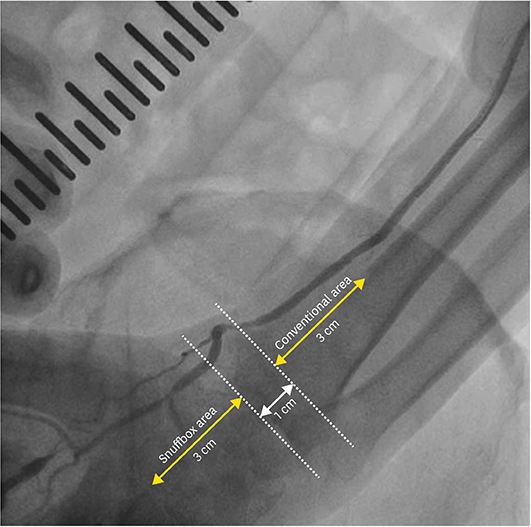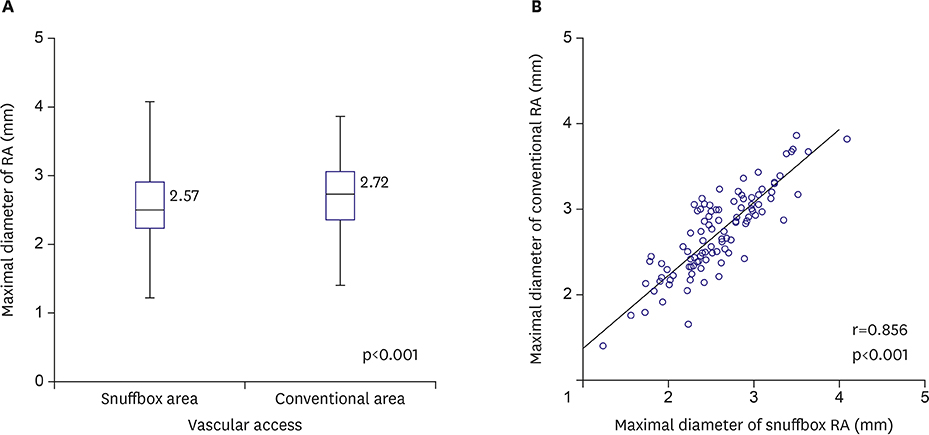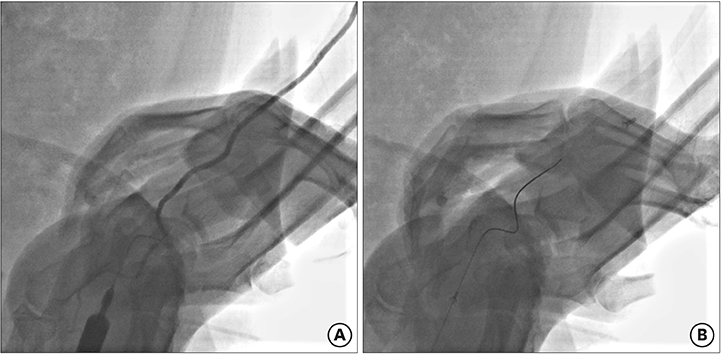Feasibility of Coronary Angiography and Percutaneous Coronary Intervention via Left Snuffbox Approach
- Affiliations
-
- 1Department of Cardiology, Cardiovascular Center, Chonnam National University Hospital, Gwangju, Korea. cecilyk@hanmail.net
- KMID: 2424561
- DOI: http://doi.org/10.4070/kcj.2018.0181
Abstract
- BACKGROUND AND OBJECTIVES
Feasibility of coronary angiography (CAG) and percutaneous coronary intervention (PCI) via left snuffbox approach is still concerned. We aimed to investigate efficacy and safety of the left snuffbox approach for CAG and PCI.
METHODS
Left snuffbox approach was tried in 150 patients who planned to perform CAG or PCI for suspected myocardial ischemia between 1 November 2017 and 31 March 2018.
RESULTS
Success rate of radial artery (RA) cannulation via snuffbox approach was 88.0% (n=132). Among 132 individuals, 58 (43.9%) acute coronary syndrome (ACS) patients were included. The diameter of snuffbox RA was significantly smaller than conventional RA (2.57 mm vs. 2.72 mm, p < 0.001) from quantitative computed angiography of 101 patients. However, CAG via snuffbox approach by 6 French sheath was successfully performed in all 132 patients. In addition, there was significant correlation between the snuffbox and conventional RA diameter (r=0.856, p < 0.001). In 42 PCI cases, including 25 patients with acute myocardial infarction (AMI), the success rate of PCI via snuffbox approach was 97.6% (n=41). Intravascular imaging-guided PCI was performed in 8 (19.5%) patients and multi-vessel PCI in 4 (9.8%) cases. Regarding vascular complication, forearm swelling with bruising, not requiring surgery or transfusion, occurred in 2 (4.9%) PCI cases.
CONCLUSIONS
Left snuffbox approach is suitable for CAG and PCI compared with the conventional radial approach.
MeSH Terms
Figure
Cited by 4 articles
-
Optical Coherent Tomographic (OCT) Finding of Radial Arterial Recanalization
Sangmin Kim, Sang Yeub Lee, Yongcheol Kim, Dae In Lee, Ju-Hee Lee, Jang-Whan Bae, Kyung-Kuk Hwang, Myeong-Chan Cho
Korean Circ J. 2020;50(11):1045-1047. doi: 10.4070/kcj.2020.0110.Distal Radial Approach through the Anatomical Snuff Box for Coronary Angiography and Percutaneous Coronary Intervention
Jae-Hyung Roh, Jae-Hwan Lee
Korean Circ J. 2018;48(12):1131-1134. doi: 10.4070/kcj.2018.0293.Snuffbox Approach for Coronary Chronic Total Occlusion Intervention Using a 7-French Sheath
Yongcheol Kim, Dae Yong Hyun, Kyung Hoon Cho, Min Chul Kim, Doo Sun Sim, Young Joon Hong, Ju Han Kim, Youngkeun Ahn, Myung Ho Jeong
Chonnam Med J. 2019;55(3):175-176. doi: 10.4068/cmj.2019.55.3.175.Successful Drug-Eluting Stent Overexpansion with Intravascular Ultrasound Guidance for Left Main Bifurcation Lesion Via Left Snuffbox Approach
Yongcheol Kim, Myung Ho Jeong, Min Chul Kim, Doo Sun Sim, Young Joon Hong, Ju Han Kim, Youngkeun Ahn
Chonnam Med J. 2019;55(1):66-67. doi: 10.4068/cmj.2019.55.1.66.
Reference
-
1. Archbold RA, Robinson NM, Schilling RJ. Radial artery access for coronary angiography and percutaneous coronary intervention. BMJ. 2004; 329:443–446.
Article2. Doyle BJ, Rihal CS, Gastineau DA, Holmes DR Jr. Bleeding, blood transfusion, and increased mortality after percutaneous coronary intervention: implications for contemporary practice. J Am Coll Cardiol. 2009; 53:2019–2027.3. Bertrand OF, Rao SV, Pancholy S, et al. Transradial approach for coronary angiography and interventions: results of the first international transradial practice survey. JACC Cardiovasc Interv. 2010; 3:1022–1031.4. Jang HJ, Kim JY, Han JD, et al. Numbness after transradial cardiac catheterization: the results from a nerve conduction study of the superficial radial nerve. Korean Circ J. 2016; 46:161–168.
Article5. Roffi M, Patrono C, Collet JP, et al. 2015 ESC Guidelines for the management of acute coronary syndromes in patients presenting without persistent ST-segment elevation: Task Force for the Management of Acute Coronary Syndromes in Patients Presenting without Persistent ST-Segment Elevation of the European Society of Cardiology (ESC). Eur Heart J. 2016; 37:267–315.6. Ibanez B, James S, Agewall S, et al. 2017 ESC Guidelines for the management of acute myocardial infarction in patients presenting with ST-segment elevation: The Task Force for the management of acute myocardial infarction in patients presenting with ST-segment elevation of the European Society of Cardiology (ESC). Eur Heart J. 2018; 39:119–177.7. Kado H, Patel AM, Suryadevara S, et al. Operator radiation exposure and physical discomfort during a right versus left radial approach for coronary interventions: a randomized evaluation. JACC Cardiovasc Interv. 2014; 7:810–816.8. Sciahbasi A, Romagnoli E, Trani C, et al. Evaluation of the “learning curve” for left and right radial approach during percutaneous coronary procedures. Am J Cardiol. 2011; 108:185–188.
Article9. Sciahbasi A, Romagnoli E, Burzotta F, et al. Transradial approach (left vs right) and procedural times during percutaneous coronary procedures: TALENT study. Am Heart J. 2011; 161:172–179.
Article10. Freixa X, Trilla M, Feldman M, Jiménez M, Betriu A, Masotti M. Right versus left transradial approach for coronary catheterization in octogenarian patients. Catheter Cardiovasc Interv. 2012; 80:267–272.
Article11. Norgaz T, Gorgulu S, Dagdelen S. A randomized study comparing the effectiveness of right and left radial approach for coronary angiography. Catheter Cardiovasc Interv. 2012; 80:260–264.
Article12. Jurga J, Nyman J, Tornvall P, et al. Cerebral microembolism during coronary angiography: a randomized comparison between femoral and radial arterial access. Stroke. 2011; 42:1475–1477.
Article13. Kiemeneij F. Left distal transradial access in the anatomical snuffbox for coronary angiography (ldTRA) and interventions (ldTRI). EuroIntervention. 2017; 13:851–857.
Article14. Soydan E, Akın M. Coronary angiography using the left distal radial approach - an alternative site to conventional radial coronary angiography. Anatol J Cardiol. 2018.
Article15. Valsecchi O, Vassileva A, Cereda AF, et al. Early clinical experience with right and left distal transradial access in the anatomical snuffbox in 52 consecutive patients. J Invasive Cardiol. 2018; 30:218–223.16. Kim Y, Jeong MH, Kim I, et al. Intravascular ultrasound-guided percutaneous coronary intervention with drug-eluting stent for unprotected left main disease via left snuffbox approach. Korean Circ J. 2018; 48:532–533.
Article17. Biondi-Zoccai G, Sciahbasi A, Bodí V, et al. Right versus left radial artery access for coronary procedures: an international collaborative systematic review and meta-analysis including 5 randomized trials and 3210 patients. Int J Cardiol. 2013; 166:621–626.
Article18. Park JY, Rha SW, Choi BG, et al. Comparison of clinical outcomes between the right and left radial artery approaches from the Korean transradial coronary intervention registry. Yonsei Med J. 2017; 58:521–526.
Article19. Santas E, Bodí V, Sanchis J, et al. The left radial approach in daily practice. A randomized study comparing femoral and right and left radial approaches. Rev Esp Cardiol. 2009; 62:482–490.
Article20. Kim SM, Tripathy DR, Park SW, et al. Impact of chronic kidney disease on clinical outcomes in diabetic patients undergoing percutaneous coronary intervention in the era of newer-generation drug-eluting stents. Korean Circ J. 2017; 47:222–230.
Article
- Full Text Links
- Actions
-
Cited
- CITED
-
- Close
- Share
- Similar articles
-
- Distal Radial Approach through the Anatomical Snuff Box for Coronary Angiography and Percutaneous Coronary Intervention
- Intravascular Ultrasound-Guided Percutaneous Coronary Intervention with Drug-eluting Stent for Unprotected Left Main Disease via Left Snuffbox Approach
- A Retrograde Approach to Coronary Ostial Stenosis after a Bentall Procedure in a Patient with Behcet's Disease
- Percutaneous Transradial Approach for Coronary Angiography
- Feasibility and Problems in Transradial Coronary Angiography and Intervention





